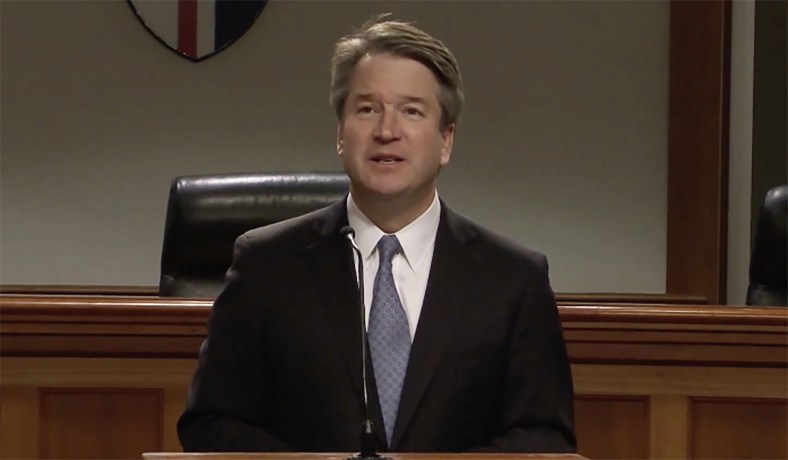Hon. Neil Gorsuch
United States Court of Appeals for the Tenth Circuit (2006-Present)
This post reviews Judge Gorsuch’s dissent in a Fourth Amendment warrantless search case.[1] Gorsuch powerfully and colorfully argues public officers have no power to intrude upon a house and its curtilage (appendages such as porch and the immediate area) when the owner revokes the ‘implied license’ via multiple ‘No Trespassing’ signs.
I found this case while searching for First Amendment opinions by Judge Gorsuch. I’m highlighting this case for a number of reasons. Occasionally, litigants challenge speech laws through other constitutional rights, including the Fourth Amendment. Equally as important, this dissent exemplifies three of Judge Gorsuch’s most impressive qualities – his superb writing, his independence, and his respect for the rule of law.
- US v. Carloss, 818 F. 3d 988 (10th Cir. 2016)
Vestiges of Oceania’s native tongue, ‘Newspeak,’ linger in the Tenth Circuit, writes newly minted Supreme Court nominee Neil Gorsuch. In Carloss, Gorsuch dissents from the majority and concurring opinions arguing ‘No Trespass’ doesn’t really mean No Trespass. It means ‘come on over’ unless artificial distinctions appear known only to ‘reasonable’ appellate judges.
Gorsuch attacks these judge-made conditions as incompatible with the Fourth Amendment. His opinion evinces a healthy skepticism of government power by police looking to escape the national charter’s strictures.
Ralph Gene Carloss roomed in a Tahlequah, Oklahoma house. The feds suspected he had illegal firearms and was selling methamphetamine. An ATF agent and a local law officer lacking a warrant went to the house investigate. The owner wasn’t keen on visitors as the majority opinion describes:
[T]here was a “No Trespassing” sign on an approximately three-foot-high wooden post located beside the driveway, on the side farthest from the house, and another sign tacked to a tree in the side yard, both stating “Private Property No Trespassing.” There was a sign, on a wooden pole in the front yard along the side of the driveway closest to the house, and a sign on the front door of the house, both stating “Posted Private Property Hunting, Fishing, Trapping or Trespassing for Any Purpose Is Strictly Forbidden Violators Will Be Prosecuted.” These signs were professionally printed, with yellow or orange lettering against a black background.
Undeterred, the officers approached the house and eventually gained consent to enter where they noticed indicia of illicit narcotics. The owner asked the pair to leave after learning they had no warrant. They returned warrant-in-hand and found several methamphetamine labs.
The case’s question is, did the multiple and conspicuous no trespassing signs revoke the implied license to enter a house’s curtilage?
Three theories from the opinion answer ‘Yes’:
- The government argued nothing revokes the government’s implied invitation while conducting a ‘knock and talk’ – a law enforcement request for voluntarily cooperation.
- The concurrence argued ‘No Trespass’ signs alone are insufficient to revoke the implied license in ‘residential areas.’ Other barriers such as a fence must also be there.
- The majority argued there were some times that signs alone could revoke the license, but the ones here didn’t cut it.
Judge Gorsuch addresses each in a colorful dissent that tries to pull Newspeak from the realm of Politics and the English Language.
Gorsuch finds the government’s argument unsupported by case law, either of the opinions, and is reductio ad absurdum:
[T]he government suggests that its officers enjoy an irrevocable right to enter a home’s curtilage to conduct a knock and talk. . . A homeowner may post as many No Trespassing signs as she wishes. She might add a wall or a medieval-style moat, too. Maybe razor wire and battlements and mantraps besides. Even that isn’t enough to revoke the state’s right to enter.
No one before us disputes that a knocker or doorbell usually amounts to an implied invitation to enter the curtilage, knock or ring at the front door, and seek leave to enter the home itself. Neither do the parties dispute that the homeowner enjoys the right to revoke this implied invitation – at least when it comes to private visitors.
[T]he government says it’s subject to different rules – and it’s here where our dispute really begins. While a homeowner may stop others from entering his curtilage, the government contends a homeowner may never stop its agents from entering the curtilage to conduct a knock and talk. Really, then, the government’s argument here isn’t that it enjoys a license or invitation flowing from the homeowner, for it turns out the homeowner has nothing to do with it. In the government’s telling, its agents enjoy a special and irrevocable right to invade a home’s curtilage for a knock and talk – what might be more accurately called a sort of permanent easement – whatever the homeowner may say or do about it.
[T]his line of reasoning seems to me difficult to reconcile with the Constitution of the founders’ design. We know that the Fourth Amendment, at a minimum, protects the people against searches of their persons, houses, papers, and effects to the same degree the common law protected the people against such things at the time of the founding, for in prohibiting “unreasonable” searches the Amendment incorporated existing common law restrictions on the state’s investigative authority. We know, too, that at the time of the founding the common law permitted government agents to enter a home or its curtilage only with the owner’s permission or to execute legal process. No trace of some sort of permanent easement belonging to the state (and state alone) can be found in the common law of the founders’ time.
If we decline to adopt its main theory on appeal, the government asks us to entertain another alternative ground for affirmance. . . [T]he government contends that No Trespassing signs aren’t the proper way to revoke it. According to the government, a homeowner may avoid a knock and talk only by hiding in the home and refusing to answer the door. Or maybe, as the government seemed to concede at oral argument, by opening the door and commanding officers to leave.
This argument is no more persuasive than the last. Actually, it’s no different from the last. A homeowner who refuses to answer the door, or who opens it to say “go away,” does so after the officers have already entered the home’s front porch and knocked on the door – everything the implied license permits the officers to do. In the government’s two scenarios, then, a homeowner hasn’t revoked the license to enter the curtilage and knock at the front door so much as the officers have exhausted the terms of that license. The government’s second argument thus really amounts only to an admission that the implied license has boundaries to its exercise, not an admission that the license may be revoked before its exercise.
Gorsuch contends the concurrence’s less strident ‘other physical barriers’ theory is equally unsupported:
The concurrence appears to take the view that No Trespassing signs cannot revoke the implied license in the “residential context” unless they are coupled with a “fence or other physical obstacle.”
True, the concurrence seems to leave open the possibility that signs alone might do their intended work in some (sufficiently) rural setting. But a careful look at its reasoning suggests a judgment that signs are categorically insufficient to revoke the implied license in the (undefined) “residential context.”
[T]he concurrence says that in the “residential context” plastering a No Trespassing sign to the center of your front door is not “particularly distinctive.” Even lining the path from the street to your porch with four (ten? twenty?) signs doesn’t change the equation. According to the concurrence, to revoke the implied license in the “residential context” we need “special facts” in addition to clearly posted No Trespassing signs – and fences, gates, and “other physical obstacle[s]” are the only “special facts” it identifies. So much is required, we are told, because a sign posted on “a fence encircling a property imparts a different message” than a “sign standing alone.” To be sure, the concurrence doesn’t say what type of “fence or other physical obstacle” might be necessary to inform neighborhood visitors that they’re unwelcome – and you might wonder how a quaint three-foot-high white picket fence might do the trick if twenty No Trespassing signs don’t.
Respectfully, I have my doubts. Not only did the government fail to present this theory anywhere in this appeal, it expressly disavowed it, telling us repeatedly that walls and fences (yes, even moats) cannot keep its agents from entering the curtilage to conduct a knock and talk. And it’s a pretty rare day when we pursue an argument for a party that the party has so avidly disowned. Neither am I persuaded that the concurrence’s argument is some sort of dead-bang winner the parties and district court somehow just missed.
While the concurrence supplies no authority to support its judgment, there seems to be ample authority running the other way, suggesting that the common law at the time of the founding did not require a property owner to express his intent to revoke a license to enter in any particular way. Indeed, all that was traditionally required were “express words … or … an act … indicating an intention to revoke.” Nothing in this common law rule of decision required both notice by word (a sign) and notice by deed (a fence). In fact, despite the relatively low literacy rates in mid-18th century England and early America, there appears to be considerable authority suggesting that posted signs or other types of published notice could suffice as a matter of law to ward off unwanted visitors.
The concurrence suggests that “reasonable person[s]” do not consider No Trespassing signs, absent a fence or other obstacle, as speaking to the implied license to enter in the “residential context.” In the concurrence’s judgment, most people know that it’s illegal to “trespass” on private property, and they also know that it generally isn’t “trespassing” to walk up to the front door of a house and knock. So, the reasoning appears to go, “reasonable persons” visiting a residential neighborhood understand the particular words “no trespassing” to refer to conduct other than the exercise of the implied license.
This intuitive appeal, though, seems to invite further problems of its own. First, as a matter of law, it disregards the common law rule of decision at the time of the founding and its many applications, then and now, suggesting that posted notice can suffice to warn off “reasonable” visitors. The Fourth Amendment is, after all, supposed to protect the people at least as much now as it did when adopted, its ancient protections still in force whatever our current intuitions or preferences might be. Second, as a matter of fact, you can’t help but wonder if millions of homeowners (and solicitors) might be surprised to learn that even a long line of clearly posted No Trespassing signs are insufficient to revoke the implied license to enter a home’s curtilage – that No Trespassing signs have become little more than lawn art.
Finally, Gorsuch tackles the majority’s ‘Sometimes but not this time theory’:
[T]he majority opinion seems to accept the possibility that signs can revoke the license in that setting or any other and presents a much more fact-bound argument about the insufficiency of the particular signs in this case.
Addressing the three signs leading to the front porch, the majority opinion begins by noting that they were posted on ground leading to the curtilage rather than on the curtilage itself. And this fact, it suggests, means a reasonable visitor wouldn’t have understood them to forbid entry into the curtilage. But it’s unclear why that conclusion follows from these facts. All three signs lined the path any visitor would follow (and the path the officers did follow) to reach the curtilage and front door. The signs came one upon the other, hard and in short order, and near the bounds of the curtilage itself.
Neither, in all events, does the majority opinion’s logic suffice to dispose of this case because at least one sign was undeniably on curtilage and clearly visible to those preparing to enter it.
To be sure, the majority opinion finds this last sign insufficient, too, if for a different reason. The majority suggests that the terms of this particular sign were too ambiguous.
But in large bold letters the sign said this:
POSTED
PRIVATE PROPERTY HUNTING, FISHING, TRAPPING, OR TRESPASSING FOR ANY PURPOSE IS STRICTLY FORBIDDEN VIOLATORS WILL BE PROSECUTED
[T]he majority opinion reasons, the sign could have been reasonably interpreted by a visitor as forbidding him only from engaging in these recreational activities elsewhere on the property and not as speaking to his entry into the curtilage where the sign was posted.
I would have thought it equally (or maybe even a good deal more) likely that a reasonable person – considering whether to enter a stranger’s front porch and staring at a large “PRIVATE PROPERTY” sign forbidding “TRESPASSING FOR ANY PURPOSE” – would take it as directed at him and his activities rather than as directed only at someone interested in hunting or fishing somewhere else on the property.
We do seem to invite quite a paradox when we suggest the first three signs are irrelevant to curtilage because they were not posted on curtilage and yet treat the final sign as irrelevant to curtilage even though it was. And a paradox, too, when we suggest that a homeowner who posts a sign containing additional and illustrative warnings (about hunting, fishing, and trapping) should forgo the force of its central and express warning (no trespassing for any purpose).
Our duty of fidelity to the law requires us to respect all these law enforcement tools. But it also requires us to respect the ancient rights of the people when law enforcement exceeds their limits. In this case the two arguments the government offers to justify its conduct can claim no basis in our constitutional tradition. Not one member of this panel endorses them. And, respectfully, I just do not see the case for struggling so mightily to save the government’s cause with arguments of our own devise – especially when what arguments we are able to muster suffer so many problems of their own and the benefits of exposing them to at least a modest encounter with the adversarial process seem so obvious.
[1] Internal citations to other cases have been omitted from the excerpts below.














